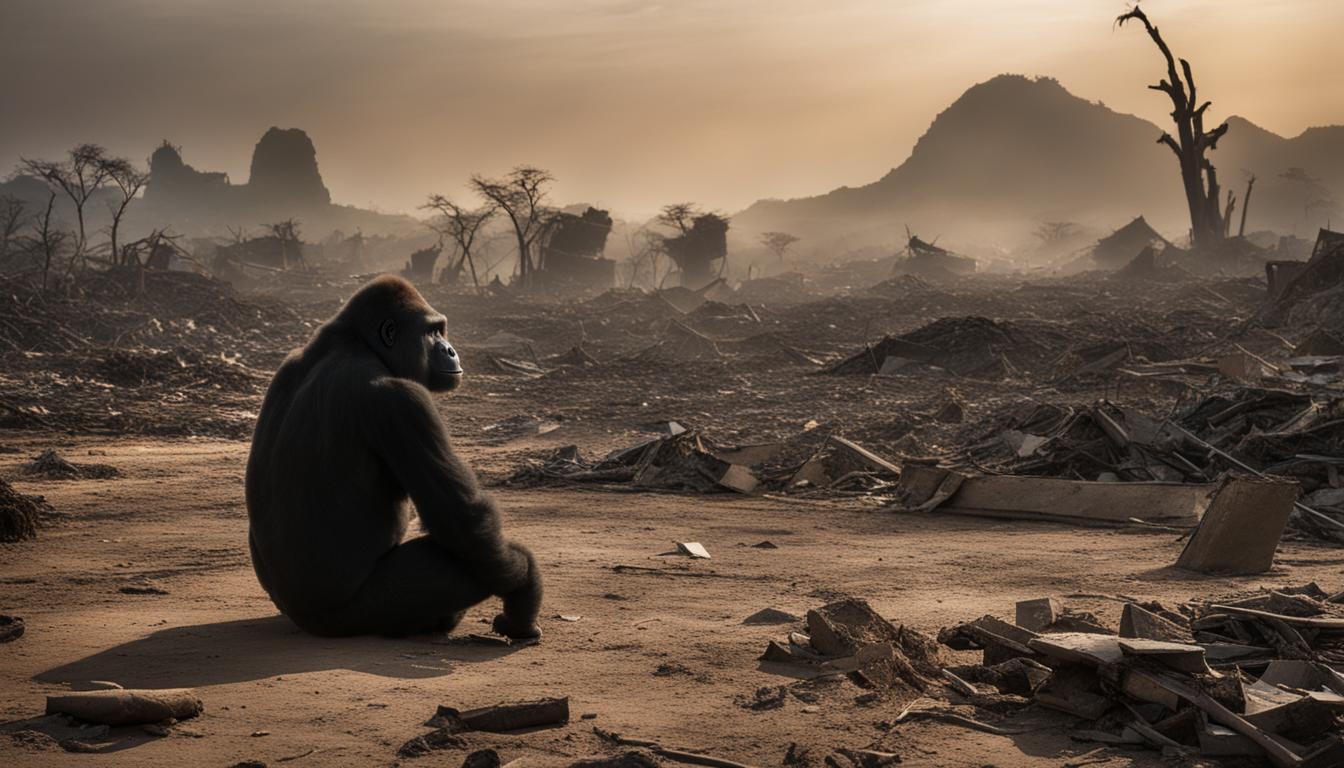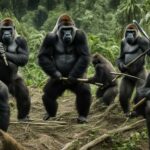Throughout history, human activities have had a significant impact on gorilla populations. The interaction between gorillas and humans has played a crucial role in shaping their conservation and education efforts. Through research and observation, we have gained valuable insights into the behavior and communication of gorillas. However, our actions have also posed threats to their survival.
Understanding the history of human-gorilla interaction is vital for ensuring the conservation of these magnificent creatures. By studying their populations, we can better identify the challenges they face and develop effective strategies to protect their habitats. Through education and awareness, we can promote a greater understanding between humans and gorillas, fostering positive connections that benefit both species.
Historical changes in gorilla populations
Gorilla populations have faced significant changes throughout history. These changes are evident in their behavior, communication patterns, and the establishment of a unique bond between humans and gorillas. Historical records indicate that in the 1980s, there were fewer than 400 mountain gorillas remaining worldwide. However, thanks to dedicated conservation efforts, the population has increased to just over a thousand individuals.
The resurgence of the mountain gorilla population can be attributed to various factors, including increased protection of their habitats, anti-poaching measures, and public awareness campaigns. However, the primary threats to their survival persist, including habitat loss, the spread of diseases, poaching, and civil unrest.
“The rise in the mountain gorilla population is a testament to the positive impact that conservation efforts can have on endangered species,” says Dr. Jane Wilson, a leading primatologist.
“Through systematic monitoring and strategic conservation initiatives, we have been able to reverse the decline and ensure the survival of these incredible creatures. The human-gorilla bond that has developed over the years has played a vital role in this conservation success story.”
| Threats to Gorilla Populations | Impact |
|---|---|
| Habitat Loss | Clearing and degradation of gorilla habitats due to human activities |
| Disease Transmission | Gorillas vulnerable to human diseases, leading to population decline |
| Poaching | Killing of gorillas for various purposes, including the live animal trade |
| Civil Unrest | Human conflicts affecting gorilla populations and their habitats |
Impact of Habitat Loss on Gorilla Populations
Gorilla populations are facing a critical threat due to habitat loss caused by human activities. As the human population continues to grow and expand, the demand for resources puts increasing pressure on gorilla habitats. The destruction and degradation of these habitats have resulted in a significant decline in gorilla populations.
To address this issue, conservation efforts are focusing on promoting responsible gorilla tourism as a means to both protect the gorillas’ natural habitat and benefit local communities. By creating opportunities for sustainable economic activities that meet the needs of the local population, responsible tourism can provide alternative sources of income, reducing the dependence on activities that harm gorilla habitats.
Education plays a crucial role in raising awareness about the importance of gorilla conservation and fostering understanding between humans and gorillas. By promoting the value of conserving these magnificent creatures and their habitats, we can inspire individuals to take action and support initiatives aimed at protecting gorillas.
Responsible Gorilla Tourism: A Path Towards Conservation
In order to ensure the long-term survival of gorilla populations, it is essential to strike a balance between human needs and conservation efforts. Responsible gorilla tourism offers a promising approach by providing sustainable economic opportunities while minimizing the negative impact on gorilla habitats.
| Benefits of Responsible Gorilla Tourism | Challenges |
|---|---|
| Promotes conservation by generating funds for habitat protection and anti-poaching efforts | Lack of awareness and understanding among tourists about responsible behavior |
| Provides employment and income for local communities, reducing the reliance on activities that harm gorilla habitats | Potential for over-tourism and disturbance to gorilla populations |
| Enhances education and awareness about gorillas, leading to a greater understanding and appreciation for their conservation | Ensuring equitable distribution of benefits among local communities |
By promoting responsible gorilla tourism, we can contribute to the conservation of these incredible animals and their habitats, creating a sustainable future where humans and gorillas can thrive together.
Promoting Ethical Wildlife Encounters and Understanding Between Humans and Gorillas
Gorilla conservation and education efforts heavily emphasize the importance of promoting ethical wildlife encounters and fostering understanding between humans and gorillas. While the desire to interact with these magnificent creatures is understandable, it is crucial to prioritize their well-being and protect them from potential harm. By adhering to ethical guidelines, we can ensure that our interactions with gorillas contribute positively to their conservation and long-term survival.
One key aspect of promoting ethical wildlife encounters is to minimize direct contact with gorillas. This helps reduce the risk of disease transmission, which can be devastating to gorilla populations. Gorillas share many genetic similarities with humans, making them susceptible to various illnesses. Even seemingly harmless viruses or bacteria that humans carry can be life-threatening to gorillas. Therefore, it is essential for visitors and researchers to maintain a respectful distance from gorillas, allowing them to thrive in their natural environment without unnecessary disturbance.
Furthermore, education plays a crucial role in promoting understanding between humans and gorillas. By raising awareness about the importance of gorilla conservation and the potential impact of human activities, we can inspire individuals to become advocates for their protection. Through educational programs and initiatives, we can empower local communities, tourists, and researchers to make informed choices that prioritize the well-being of gorillas. By fostering a sense of responsibility and respect, we can create a positive environment for both humans and gorillas to coexist harmoniously.
“Responsible tourism and ethical encounters with gorillas are fundamental in ensuring the survival of these magnificent creatures. By respecting their natural behaviors and habitat, we can help protect them for future generations.” – Dr. Jane Goodall
Table: Ethical Guidelines for Wildlife Encounters
| Guideline | Description |
|---|---|
| Keep a safe distance | Maintain a respectful distance from gorillas to minimize stress and avoid disease transmission. |
| Follow designated trails | Stick to designated paths and avoid venturing into restricted areas to protect gorilla habitats. |
| Respect their space | Avoid making sudden movements or loud noises that could startle or distress gorillas. |
| Do not touch or feed | Refrain from touching or feeding gorillas as it disrupts their natural behavior and can introduce harmful pathogens. |
| Stay in small groups | Limit the number of visitors to maintain a calm environment and minimize the impact on gorilla populations. |
By promoting ethical wildlife encounters and fostering understanding between humans and gorillas, we can create a sustainable future for these remarkable creatures. Together, we can ensure their protection, preserve their habitats, and inspire others to appreciate the beauty and importance of gorillas in our natural world.

Threats from Poaching and Hunting
Gorilla populations are facing significant threats from poaching and hunting, which have had a detrimental impact on their numbers and overall conservation efforts. In the past, gorillas were targeted by scientists and trophy hunters, leading to a decline in their population. However, more recent incidents of direct poaching, including the killing of gorillas or the capture of infants for the live animal trade, have added to the challenges faced by these majestic creatures.
Unselective hunting with snares meant for other wildlife also contributes to the death or injury of gorillas. The indiscriminate nature of these hunting methods puts gorillas at great risk, as they can easily become entangled or injured in the traps. Conservation efforts are focused on combatting poaching and preserving the gorilla population by fostering positive connections between humans and gorillas.
In order to address the threats from poaching and hunting, it is vital to raise awareness and educate local communities about the importance of gorilla conservation. By promoting a deeper understanding of gorillas and their critical role in the ecosystem, we can encourage people to become advocates for their protection. These efforts also include supporting anti-poaching patrols, implementing stricter laws and penalties for illegal hunting, and providing alternative livelihood options for communities that rely on wildlife exploitation for their survival.
The Impact of Poaching and Hunting on Gorilla Populations
“Poaching and hunting pose a significant threat to gorilla populations. Conservation efforts focus on fostering positive gorilla-human connections to combat poaching and preserve the gorilla population.”
Poaching and Hunting Statistics
| Threat | Impact on Gorilla Populations |
|---|---|
| Direct Poaching | Increase in gorilla deaths and capture for the live animal trade |
| Indiscriminate Hunting | Death or injury of gorillas due to traps set for other wildlife |
| Historical Hunting | Decline in gorilla population due to scientific research and trophy hunting |
Efforts to address the threats from poaching and hunting require a multi-faceted approach that focuses on both enforcement and education. By fostering positive gorilla-human connections, promoting responsible wildlife encounters, and implementing strict anti-poaching measures, we can work together to preserve the gorilla population for future generations.
Human Conflicts and Civil Unrest
Human conflicts and civil unrest have had a significant impact on gorilla populations. During the Rwandan genocide in 1994 and the subsequent civil war in the Democratic Republic of the Congo (DRC), refugees sought shelter in gorilla park networks. The park systems became battlegrounds and safe havens for militias, resulting in the deaths of many gorillas. Over 100 rangers have also lost their lives protecting the park system from external threats. Gorilla research and observation, along with conservation and education efforts, play a crucial role in mitigating the impact of human conflicts on gorilla populations.
As human conflicts escalate, gorillas often become unintentional victims. The destruction of their natural habitats, loss of resources, and disruption of their social structures have lasting consequences on gorilla populations. The violence and instability caused by civil unrest create challenges for researchers and conservationists, making it difficult to conduct extensive research or implement effective conservation strategies.
“The impact of human conflicts and civil unrest on gorillas is devastating. As conservationists, it is our duty to protect these magnificent creatures from the collateral damage caused by human conflicts. Through ongoing research and observation, we can gain valuable insights into the effects of these conflicts on gorilla behavior and populations, which will inform conservation efforts and help mitigate their impact. Additionally, educating local communities about the importance of gorilla conservation is crucial for fostering a sense of responsibility and ensuring their long-term survival.”
Despite the challenges, gorilla research and observation continue to shed light on the consequences of human conflicts and civil unrest. By closely monitoring gorilla populations in conflict-affected regions, researchers can identify areas that need immediate intervention and implement strategies to protect gorillas from further harm. Conservation and education efforts are also essential for raising awareness among local communities and promoting sustainable practices that minimize the negative impact of human activities on gorillas.
Gorilla Population Status in Conflict-Affected Regions
| Region | Estimated Gorilla Population |
|---|---|
| Virunga Massif, Rwanda, Uganda, and DRC | 604 |
| Bwindi Impenetrable National Park, Uganda | 459 |
| Cross River, Nigeria, and Cameroon | around 250 |
| Maiko National Park, DRC | Undetermined due to recent conflicts |
The table above provides an overview of the estimated gorilla populations in conflict-affected regions. It is important to note that these numbers are subject to change as ongoing conflicts continue to impact gorilla habitats and populations. Efforts must be made to protect these remaining populations and ensure their long-term survival.
Addressing Climate Change and Other Threats
As gorilla populations face mounting challenges, addressing climate change and other threats becomes imperative for their survival. Climate change has the potential to disrupt gorilla health and behavior, leading to further population decline. It is crucial that conservation and education efforts prioritize raising awareness about the impact of climate change on gorillas and promote sustainable practices to mitigate its effects.
In addition to climate change, other threats such as resource exploitation, disenfranchisement among local communities, and disruptions to gorilla habitats also jeopardize their well-being. These issues require comprehensive approaches that involve fostering understanding between humans and gorillas. By promoting education and conservation initiatives, we can help locals understand the importance of gorilla conservation and provide sustainable alternatives to resource exploitation.
“The relationship between humans and gorillas is delicate and complex. Our actions have the power to either harm or protect these majestic creatures. It is our responsibility to ensure that our interactions with gorillas are respectful, informed, and environmentally conscious.”
Through promoting understanding and empathy, we can foster positive connections between humans and gorillas, encouraging responsible wildlife encounters and reducing the risk of poaching and habitat destruction. By working together, we can create a future where gorillas thrive in their natural habitats, contributing to the biodiversity and ecological balance of our planet.
| Threats | Impact |
|---|---|
| Habitat loss | Clearing and degradation of gorilla habitats due to human activities |
| Disease transmission | Gorillas vulnerable to human diseases leading to population decline |
| Poaching and hunting | Direct killing of gorillas and capture of infants for the live animal trade |
| Human conflicts and civil unrest | Gorillas caught in the crossfire of human conflicts, resulting in casualties |
| Climate change | Disruptions to gorilla health and behavior due to changing environments |
Conclusion
Throughout history, human activities have had a profound impact on gorilla populations. Our interaction with gorillas has shaped their behavior, communication, and established a unique bond between our species. However, this interaction has not always been positive. Habitat loss, disease transmission, poaching, and conflicts have posed significant threats to gorillas.
Conservation and education efforts are essential in promoting a better understanding between humans and gorillas. By fostering responsible wildlife encounters and promoting sustainable practices, we can ensure the well-being of gorilla populations. It is crucial to raise awareness about the impact of climate change and address the challenges that gorillas face due to disruptions in their health and behavior.
By working together, we can protect gorillas and preserve their natural habitats for future generations. Through continued research, observation, and conservation initiatives, we can create a future where humans and gorillas coexist in harmony. Let us embrace our responsibility to safeguard these magnificent creatures and promote a deeper understanding of their importance to our planet.
What similarities and differences exist in the historical impact of humans on gorilla and chimpanzee populations?
The historical humans impact on chimpanzee populations has been significant. Both gorilla and chimpanzee populations have suffered from habitat destruction, hunting, and disease transmission due to human activity. However, chimpanzee populations have been more severely impacted due to their susceptibility to diseases like Ebola, leading to larger population declines.
FAQ
How have humans impacted gorilla populations historically?
Humans have significantly affected gorilla populations throughout history through activities such as habitat loss, disease transmission, poaching, and conflicts.
What are some historical changes in gorilla populations?
Changes in gorilla behavior, communication patterns, and the establishment of a bond between humans and gorillas have been observed. Conservation efforts have helped increase the population of mountain gorillas from less than 400 in the 1980s to just over a thousand today.
What is the primary threat to gorilla populations?
The primary threat to gorilla populations is habitat loss due to human activities. As the human population grows, gorilla habitats are being cleared and degraded. Conservation efforts focus on promoting responsible gorilla tourism and investing in sustainable alternatives for local communities.
What are the disease risks from human-gorilla interaction?
Gorillas are vulnerable to many of the same diseases as humans. First-time exposure to an innocuous virus or illness for humans can be devastating for gorilla populations. It is crucial to promote ethical wildlife encounters and educate people about the risks involved in close contact with gorillas.
What are the threats from poaching and hunting?
Poaching and hunting pose significant threats to gorilla populations. Gorillas have been killed for scientific purposes, as trophies, and for the live animal trade. Unselective hunting with snares meant for other wildlife also results in the death or injury of gorillas. Conservation efforts focus on fostering positive gorilla-human connections to combat poaching.
How have human conflicts and civil unrest impacted gorilla populations?
Human conflicts and civil unrest, such as the Rwandan genocide and the civil war in the Democratic Republic of the Congo, have had a significant impact on gorilla populations. Refugees seeking shelter in gorilla park networks turned them into battlegrounds and safe havens for militias, leading to the deaths of many gorillas. Gorilla research, conservation, and education efforts play a crucial role in mitigating this impact.
How are climate change and other threats addressed for gorilla populations?
Conservation and education efforts raise awareness about the impact of climate change and promote sustainable practices. By fostering understanding between humans and gorillas, these efforts contribute to the long-term survival of gorilla populations.
How can humans and gorillas coexist in a sustainable way?
By promoting responsible wildlife encounters, investing in gorilla conservation and education, and addressing the challenges of habitat loss, disease transmission, poaching, and conflicts, humans and gorillas can coexist in a way that ensures the survival and well-being of gorilla populations for generations to come.











